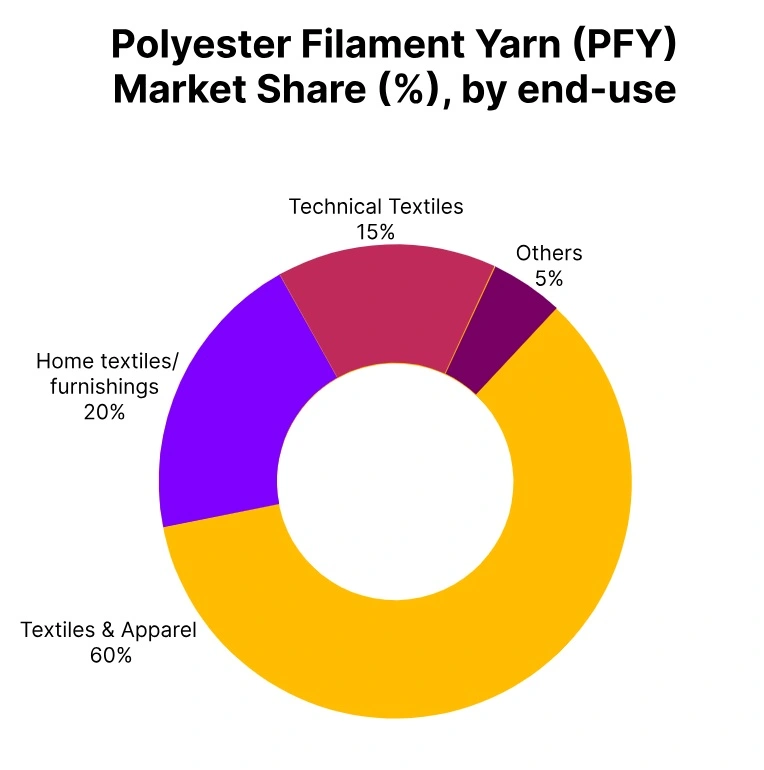Price-Watch’s most active coverage of Polyester Filament Yarn (PFY) price assessment:
- Super Bright FDY 150D/48F FOB Nhava Sheva, India
- Super Bright FDY 150D/48F CIF Alexandria (India), Egypt
- Super Bright FDY 150D/48F CIF Antwerp (India), Belgium
- Semi Dull FDY 150D/96F FOB Shanghai, China
- Semi Dull FDY 150D/96F CIF Chittagong (China), Bangladesh
- Semi Dull FDY 150D/96F CIF Jakarta (China), Indonesia
- Semi Dull FDY 150D/96F CIF Santos (China), Brazil
- Semi Dull FDY 150D/96F CIF Haiphong (China), Vietnam
Polyester Filament Yarn (PFY) Price Trend Q3 2025
In Q3 2025, global Polyester Filament Yarn (PFY) prices posted a gradual increase of 1- 4%, underpinned by steady feedstock expenses, rising textile/apparel demand, and strengthening global trade flows.
Regional price patterns reflected differences in freight charges, currency shifts, and local inventory approaches. By September, the Polyester Filament Yarn (PFY) price trend maintained cautious optimism, as producers and exporters balanced supply expansions against steady demand growth in core markets.
India
Polyester Filament Yarn (PFY) Export prices FOB Nhava Sheva, India, Grade- Super Bright FDY 150D/48F.
Polyester Filament Yarn prices in India displayed an upward price trend in Q3 2025, rising 1–2% compared to Q2. The Polyester Filament Yarn (PFY) price trend in India reflected robust demand from local textile mills and consistently strong export orders throughout the quarter, supported by stable PET resin input costs and improved downstream yarn consumption.
Producer confidence contributed to stable-to-higher pricing even as freight and currency volatility presented headwinds. In September 2025, Polyester Filament Yarn prices in India registered between USD 1100 and 1200 per metric ton, buoyed by healthy restocking sentiment and durable order flows from the textile sector.
Egypt
Polyester Filament Yarn (PFY) Import prices CIF Alexandria, Egypt (From India), Grade- Super Bright FDY 150D/48F.
Polyester Filament Yarn prices in Egypt maintained a steady price trend through Q3 2025, closing the period essentially flat compared to Q2 with import contracts benefitting from lower freight and a softening rupee. The Polyester Filament Yarn (PFY) price trend in Egypt was supported by stable demand from textile and garment factories and further strengthened by efficient logistics.
Currency-driven cost advantages played a role in containing upward price pressures. In September 2025, Polyester Filament Yarn prices in Egypt remained consistent, as local importers registered ongoing, healthy procurement against a backdrop of cost steadiness.
Belgium
Polyester Filament Yarn (PFY) Import prices CIF Antwerp, Belgium (From India), Grade- Super Bright FDY 150D/48F.
Polyester Filament Yarn prices in Belgium demonstrated a flat to slightly rising price trend in Q3 2025, with lower freight mostly offsetting rupee weakness. The Polyester Filament Yarn (PFY) price trend in Belgium tracked solid textile demand, especially in apparel and upholstery, with incremental orders reinforcing the quarter’s firmness.
Focus remained on supply continuity and currency changes as determinants of price direction. In September 2025, Polyester Filament Yarn prices in Belgium approached Q2 highs, supported by steady end-use demand and active procurement.
China
Polyester Filament Yarn (PFY) Export prices FOB Shanghai, China, Grade- Semi Dull FDY 150D/96F.
According to Price-Watch AI, in Q3 2025, Polyester Filament Yarn prices in China showed a firm upward price trend, advancing 3–4% compared to Q2. The Polyester Filament Yarn (PFY) price trend in China benefited from robust export demand and stable PET feedstock values, supporting firm factory run rates and resilient downstream fabric and garment consumption.
Freight stability allowed sustained price appreciation and confidence through the quarter. In September 2025, Polyester Filament Yarn prices in China settled in the USD 950–1020 per metric ton range, maintaining momentum and good export activity into autumn.
Bangladesh
Polyester Filament Yarn (PFY) Import prices CIF Chittagong, Bangladesh (From China), Grade- Semi Dull FDY 150D/96F.
Polyester Filament Yarn prices in Bangladesh surged 5–6% in Q3 2025, reflecting a clear upward price trend. The Polyester Filament Yarn (PFY) price trend in Bangladesh was shaped by elevated freight rates and a strong rebound in textile and knitwear sectors, promoting higher landed costs for importers.
Competition for supply and logistics bottlenecks fueled further price increases. In September 2025, Polyester Filament Yarn prices in Bangladesh climbed as imported volumes were hotly contested and demand remained assertive.
Indonesia
Polyester Filament Yarn (PFY) Import prices CIF Jakarta, Indonesia (From China), Grade- Semi Dull FDY 150D/96F.
Polyester Filament Yarn prices in Indonesia rose 2–3% in Q3 2025, indicating a gently positive price trend. The Polyester Filament Yarn (PFY) price trend in Indonesia followed incremental recovery in the textile sector, helped by improved garment output and steady local use.
Freight relief provided partial restraint to rising costs. In September 2025, Polyester Filament Yarn prices in Indonesia continued to build as supply chains normalized and buyers accepted gradual increases for restocking.
Brazil
Polyester Filament Yarn (PFY) Import prices CIF Santos, Brazil (From China), Grade- Semi Dull FDY 150D/96F.
Polyester Filament Yarn prices in Brazil jumped 6–7% during Q3 2025, confirming a strong upward price trend. The Polyester Filament Yarn (PFY) price trend in Brazil responded to sharp freight gains and increased demand in the textile and upholstery markets.
Local importers actively raised offers to match logistics outlay, while buyers kept momentum as conditions improved. In September 2025, Polyester Filament Yarn prices in Brazil remained elevated, underpinned by improved industrial activity and the sustaining impact of infrastructure growth.
Vietnam
Polyester Filament Yarn (PFY) Import prices CIF Haiphong, Vietnam (From China), Grade- Semi Dull FDY 150D/96F.
In Q3 2025, Polyester Filament Yarn prices in Vietnam moved up by 3–4% against Q2, maintaining a positive price trend. The Polyester Filament Yarn (PFY) price trend in Vietnam was supported by steady freight rates and increased demand from textile mills and garment exporters.
Active restocking and plentiful orders characterized the market. In September 2025, Polyester Filament Yarn prices in Vietnam strengthened, staying on track with ongoing procurement and favorable supply conditions.







